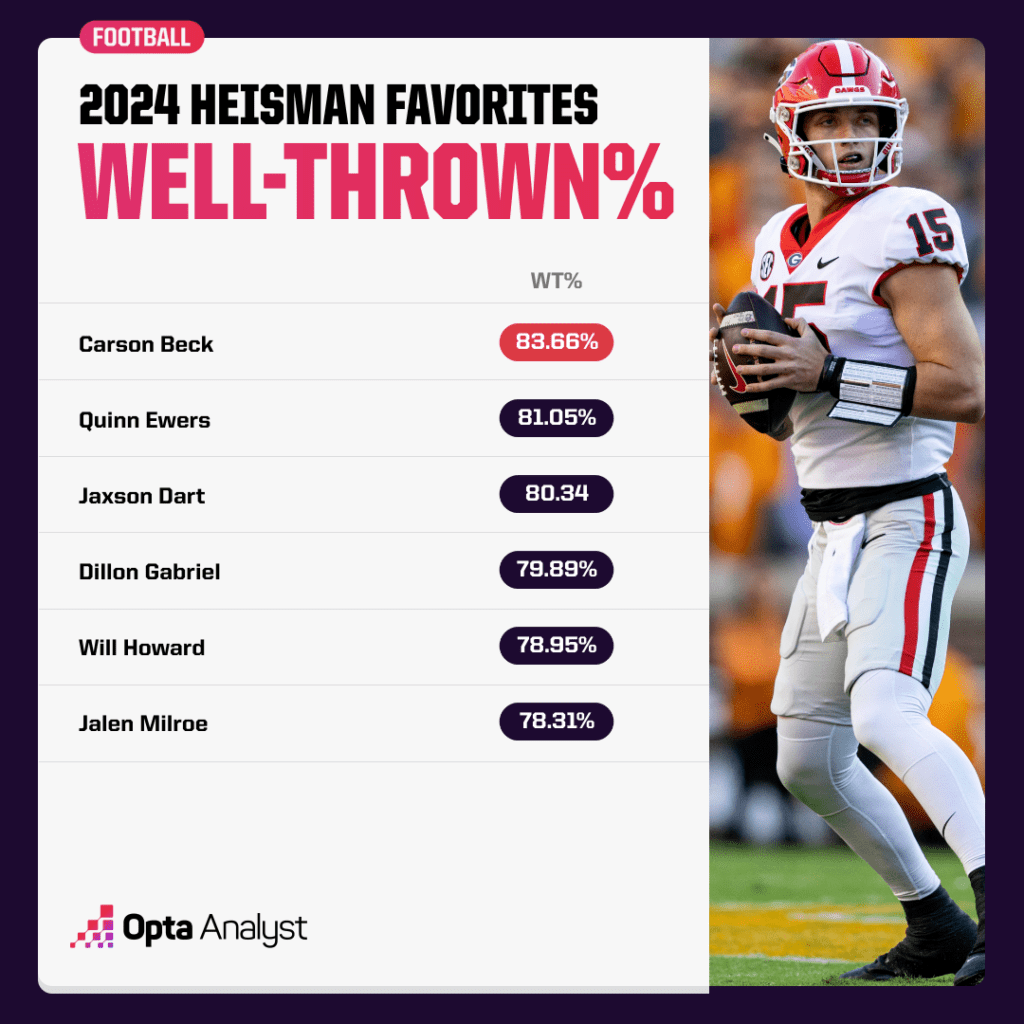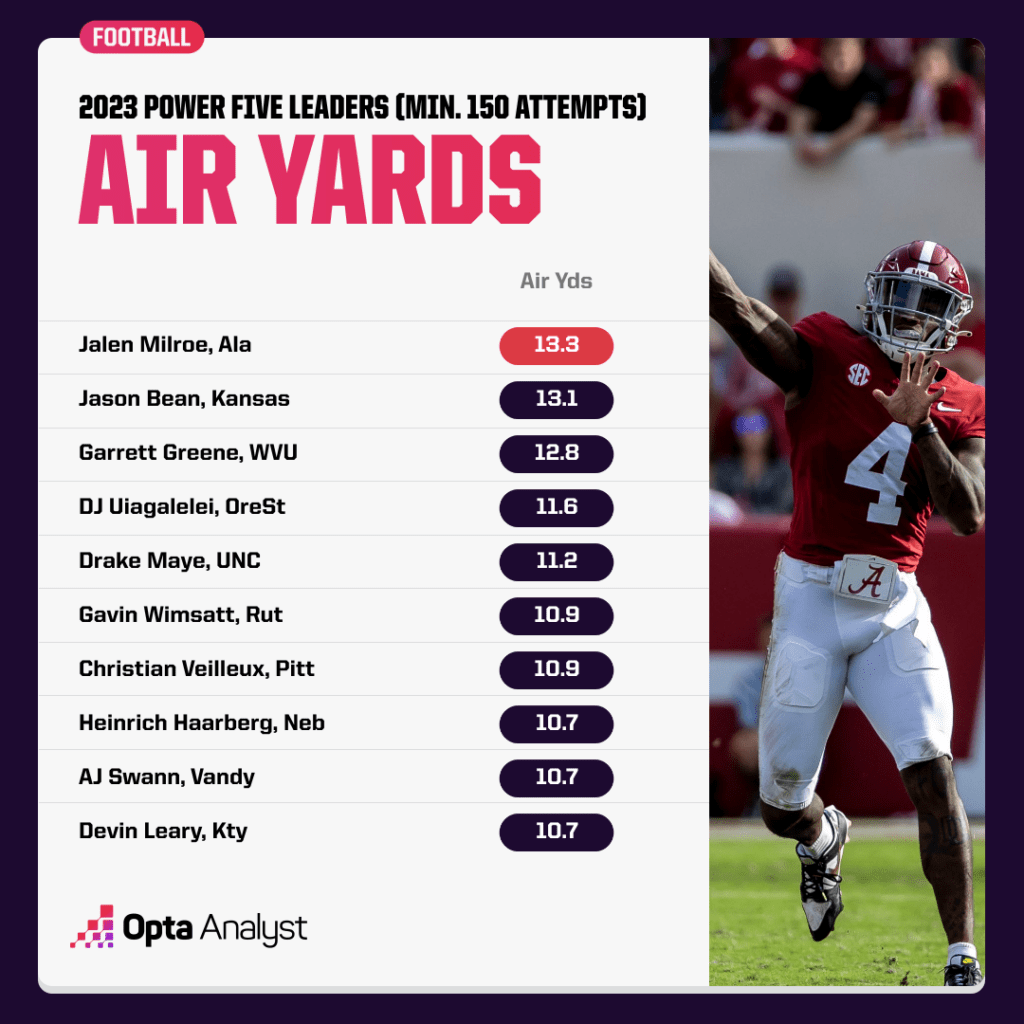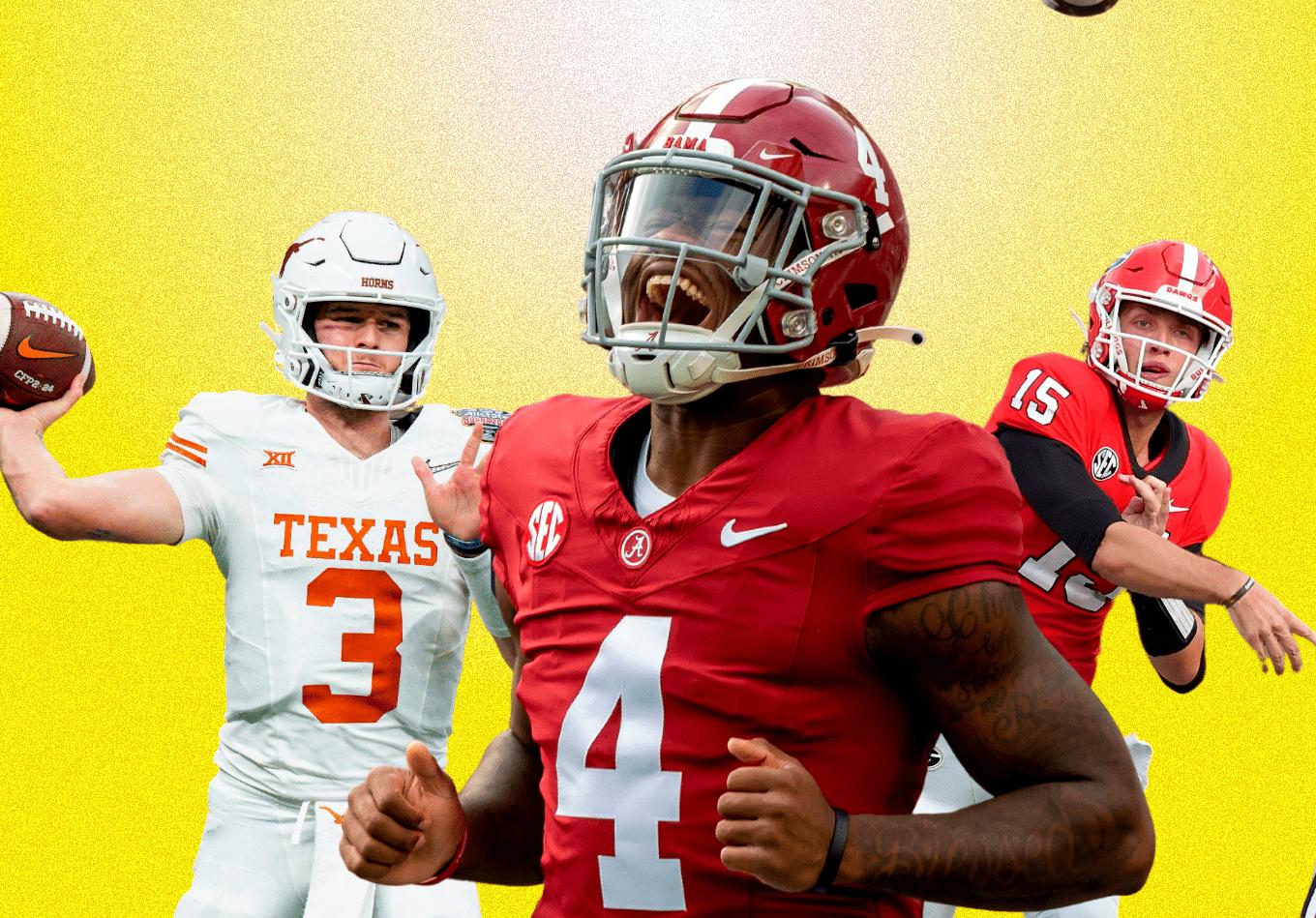It’s never too early to examine who might be the 2024 season’s top football player. So we’re making the case for each of the top six in the preseason Heisman race.
The Heisman Trophy race is unusually open heading into the 2024 season.
Most years, there’s a clear-cut favorite for college football’s top individual award. That player usually doesn’t win the award, and maybe that tells us something about the usefulness of making preseason Heisman predictions.
But summer Heisman predictions serve another purpose: They help casual fans frame up the season ahead by defining the players that everyone will be watching. In 2024, it’s harder to pick out those potential Heisman finalists.
The current Heisman Trophy winner favorite is Georgia quarterback Carson Beck. But by favorite standards, he’s a long shot at +800 betting odds. Compare that to the past three preseasons, when future NFL Draft picks Caleb Williams of USC (+400 in 2023), Ohio State’s C.J. Stroud (+200 in 2022) and Oklahoma’s Spencer Rattler (+550 in 2021) reigned as considerably heavier favorites.
The sport had its “it” players before toe met leather on Labor Day weekend. This regular season, in a refreshing change of pace, offers a less developed battle for attention.
Who will turn out to be the 2024 college football season’s top player? Spoiler: We don’t know. But here’s the case for each of the six preseason favorites in the Heisman race – all quarterbacks, of course – with help from our game-tracking data.
Carson Beck, Georgia (+800)
Beck is the favorite not because anyone thinks he’s the best player in the nation but because he’s the quarterback of a shoo-in College Football Playoff team and national championship contender. The ways Beck benefits from being a Georgia Bulldog are clear: He plays within a well-designed system with good players around him, and he does his job.
Beck’s “in-design” percentage, the rate of throws on which he targets someone in his route progression, was 85.6% in 2023 – far more than anyone else on this list. His average target was 8.3 air yards downfield, putting him below the national average in depth of target (9.2). He threw 97 screen passes – again, far more than any of his fellow Heisman contenders. The Dawgs do not use him much as a designed runner (21 times for a 1.7-yard average last year).
But Beck adds to Georgia’s embarrassment of riches, too, rather than just leeching off it. His well-thrown percentage (83.7) was higher than any other preseason Heisman contender.

And while UGA called plays that worked for Beck, he wasn’t throwing to more wide-open receivers than his peers. His 79.5% open-target rate was lower than several other contenders, despite all of those receptions on screens the Dawgs put on a platter for him.
Quinn Ewers, Texas (+900)
Ewers may not even be the most famous QB on his own roster, but he remains Texas’ entrenched starter ahead of sophomore Arch Manning. Where Ewers stands out among his fellow Heisman potentials is in his style of play. He’s a drop-back passer whose success rests entirely on his arm.
The run game isn’t part of his repertoire, as Texas dialed up just six designed runs for him in 2023, and they went nowhere (average gain: 0.5 yards). He was a solid scrambler, taking off 35 times for 6.4 yards. But the last quarterback to win the Heisman with fewer than 97 credited carries in a season was Jameis Winston in 2013.
Maybe Ewers’ arm and the Longhorns’ receivers (no longer including Xavier Worthy, but with Alabama’s Isaiah Bond joining up) will be good enough to do the job. Ewers’ benefitted from an 82.4% open-target rate last year, which was No. 1 among the ‘24 Heisman hopefuls, and kept things tidy for his team.
Ewers’ average time to throw (2.45 seconds) and pickable pass percentage (2.89%) were among the smallest figures in the country.
Dillon Gabriel, Oregon (+1000)
Gabriel arrives at his third school after three years at UCF and two at Oklahoma. All the while, he’s been one of the better QBs in the FBS.
Whether he makes the leap to nationally elite status in the Pac-12 depends mostly on how much Gabriel and Oregon’s existing offense adapt to each other.
As we broke down in our analysis of national title contenders’ weaknesses, Gabriel was good at Oklahoma, but he played a much more aggressive style than what Oregon laid out for Bo Nix:
“Gabriel is expected to succeed Nix as the Ducks’ starting quarterback, but while playing at Oklahoma, he was in a much different system last year. He averaged 9.8 air yards per attempt, had 53 designed run attempts to Nix’s 30, posted a much-lower well-thrown rate of 80%, and released the ball in 2.59 seconds compared to 2.43 for Nix. He also threw pickable passes nearly three times as often as Nix (as a percentage of his throws) and made fewer of his throws in structure: His “in-design” rate was 73.7%.”
An underrated element of Gabriel’s arsenal is his usefulness on designed runs. Oklahoma gave him 53 designed carries last year, and he produced a 6.1-yard average on them.
Jalen Milroe, Alabama (+1400)
In 2023, Milroe topped the Power Five rankings in air yards per attempt (13.3). He could throw a ball through a brick wall, and Nick Saban and coordinator Tommy Rees had no problem letting him air it out.

Saban and Rees are now gone, of course, and Milroe now has a new head coach, Kalen DeBoer, and a somewhat different supporting cast with the Crimson Tide. Receiver Germie Bernard, who followed DeBoer from Washington, is poised to become an important target for Milroe.
It would take a lot for Milroe to win the Heisman. Alabama would need to exceed expectations in a transition year, and he’d need to get more accurate. His 78.3% well-thrown rate from a season ago is the lowest among the top six Heisman candidates, and it really doesn’t capture how bad Milroe looked at times. In certain weeks, he appeared to have no idea where the ball was going when it left his powerful right arm.
Fixing that will be the key to a lot more than his 2024 Heisman hopes. But even without passing improvement, Milroe is the most dangerous runner on this list by a wide margin. His 68 scrambles for a 6.3-yard average demonstrate that when he’s holding the ball, a play is never dead.
Will Howard, Ohio State (+1500)
Howard is the most fascinating QB of the 2024 season because of his recent change in circumstances. He was an effective player at Kansas State over the past few seasons, notably leading the Wildcats to a Big 12 title in 2022.
He wasn’t bad in 2023, but he lost some snaps as the season went on to athletic young backup Avery Johnson, who may well have beaten him out for the job this fall. Yet Howard was good enough for the Buckeyes, which brought him to the Big Ten to replace the disappointing Kyle McCord.
Nobody knows how similar the Howard of Columbus will be to the Howard of Manhattan. At K-State, Howard captained a gap-running offense that featured him heavily on the ground. (His 61 designed carries went for an excellent 6.9-yard average.)
But Howard did not have an elite receiving group, and flinging the ball around the yard was not the primary tactic of coach Chris Klieman and coordinator Collin Klein. Howard’s open-target percentage (72.5) was much lower than any other QB getting serious Heisman consideration this fall. Relatedly, his 5.26% pickable-pass rate was the worst of the pack.
Now he’ll have perhaps the best wide receivers in the country, led by veteran Emeka Egbuka and all-world freshman Jeremiah Smith. What Howard does with a CFP contender in Columbus is anyone’s guess, but the upside is huge.
Jaxson Dart, Ole Miss (+1500)
Ole Miss has never had a Heisman winner and hasn’t won the SEC since before integration. Dart is the guy trying to flip a couple of pieces of history this fall.
The long-ago USC transfer was impressive last year, posting a gorgeous conventional stat line (9.4 yards per throw, 23 touchdowns, five interceptions and eight rushing TDs) while also posting encouraging peripheral numbers. Dart averaged 10.3 air yards (more than anyone on this list except Milroe) and still managed an 80.3 well-thrown percentage.
He’s athletic enough to help Ole Miss in the run game and put up a prolific line, but so much depends on how a gradually overhauled roster fits around him.
Ole Miss let star running back Quinshon Judkins leave in the transfer portal for Ohio State and lost another potential starter, Kedrick Reescano, in the spring portal window. But the Rebels brought in a whole bushel of transfer tailbacks to replace him, including Henry Parris from Miami (FL), Rashad Amos from Miami (OH) and LSU’s Logan Diggs.
Keep an eye on Amos, who was one of the best backs in the Group of Five and offered strong pass protection.
Be sure to check out all our MLB, NBA, college football and NFL coverage. And follow us on X and Instagram for more!
